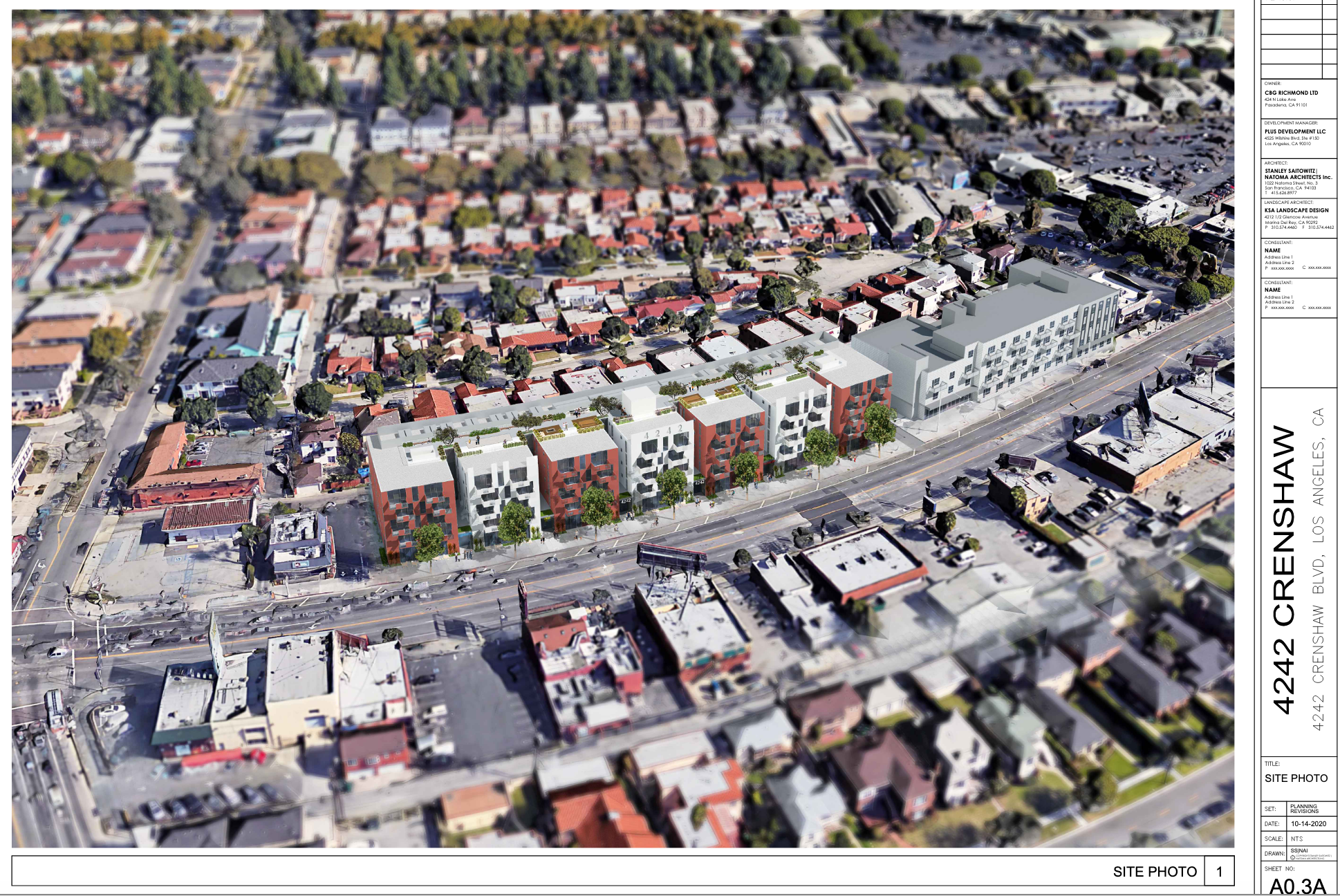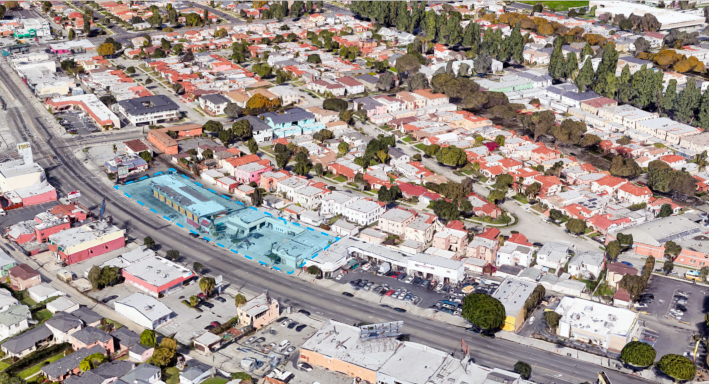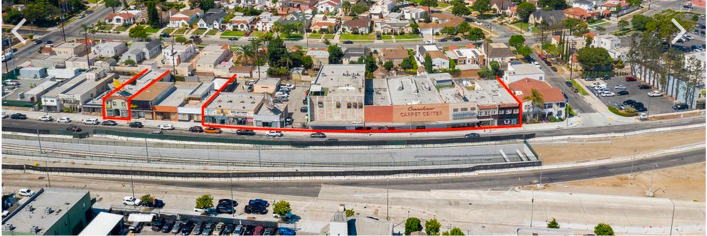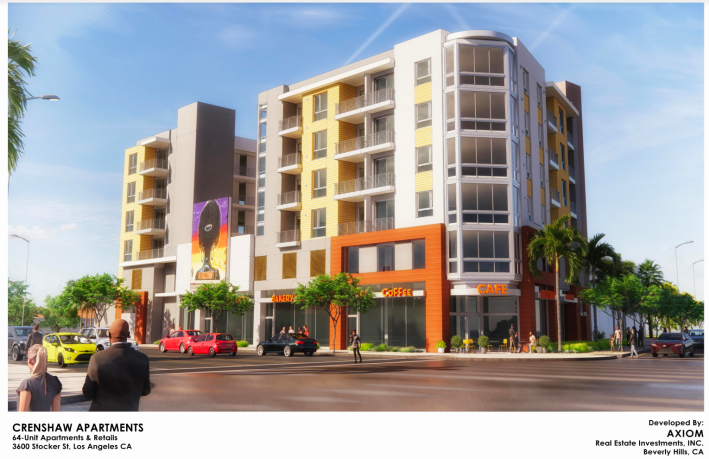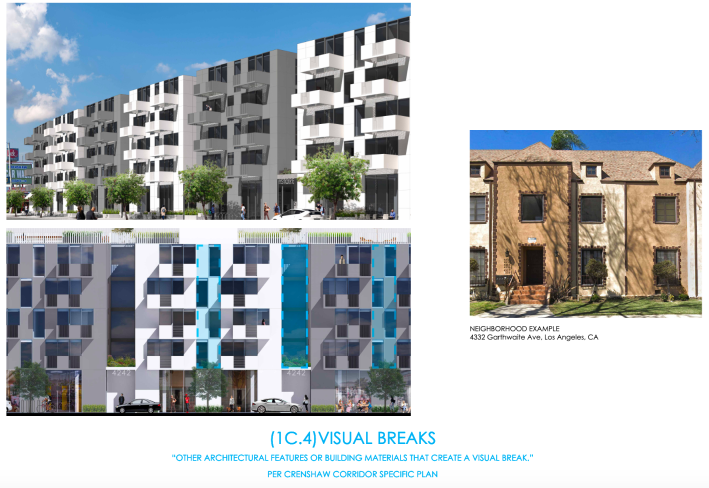Last Thursday, the 124-unit mixed-use development (with 14 affordable units at the Very Low Income level) planned to replace the car wash and auto body at 4218-4248 S. Crenshaw Boulevard was approved by the city planning commission (CPC). The transit-oriented project, notable for supplying parking for just under half of the 124 units, will sit within a block of the Leimert Park Crenshaw Line station planned to open next year. The project will move on to the city council for final approval in the coming weeks.
The proposal by the Community Builders Group (CBG) was approved with almost no discussion. Just one stakeholder, Rashida Washington, called in to ask the CPC to consider what it meant to build yet another largely market-rate project in the historic Black community.
Washington cited the Cumulus tower, where the starting rents are over $3,100, and the larger Cumulus district that will include more housing, a Whole Foods, and retail as one of a number of developments reshaping both the landscape in South L.A. and the ability of its existing residents to stay there.
Though the Cumulus will likely have significant ripple effects over the long term along the the western edge of South L.A., where it is located, the current slate of projects recently completed or in the works along Crenshaw will have a much more immediate impact on the city's historic Black business corridor.
The CBG project at 4242 S. Crenshaw will join the 111-unit shipping container project (with 13 affordable units) next door at 4252, the 64-unit project slated to go in across the street at the Liquor Bank, and others at both ends of the corridor, including the 400-unit Crenshaw Crossing project at Exposition that is still making its way through the approvals process (and which may see up to half of the units reserved as affordable), the recently completed 75-unit project (with just 9 affordable units) at 61st and Crenshaw, the planned 65-unit project (with 10 affordable units) at 59th and Crenshaw, and the razing of Dorset Village's 200-plus rent-controlled units at Crenshaw and Slauson to make way for 782 units of largely market-rate housing (and not nearly enough affordable housing to replace the lost rent-controlled units).
The Baldwin Hills Crenshaw Plaza, just one block up, is also expected to see big changes, should the sale of the site to LIVWRK co-founder Asher Abehsera be finalized [developer CIM abandoned its bid for the project this spring]. But it does not appear that any future plans will include the housing that the previous developer, Capri, had planned to build.
And just a few blocks to the south, an 8-parcel tract including housing and retail at 46th (specifically, 4605-4637 and the barbershop at 4707, seen below) was recently put on the market. The listing describes it as an excellent "opportunity for adaptive reuse, value-add, or redevelopment...for savvy investors who are aware of the tectonic shifts in capital investment occurring along this and nearby commercial corridors." The location of the property in an Opportunity Zone, the listing continues, means "additional potential tax benefits for both the investor and potential users of the existing spaces or as new development."
Setting rents aside for a moment, of all these developments, the CBG project is the one that seems to be most responsive to the look and feel of the community.
Just a few weeks ago, for example, Axiom, the developer for the Liquor Bank site, had to go back to the Crenshaw Corridor Design Review Board with a revised proposal for its project. The original version moved the Elixir mural - a beloved community landmark painted by artist Patrick Henry Johnson in 2011 - high up off the street and set it facing southward. Community members complained it would no longer engage and watch over the street in the same way and that any new construction next door to it could potentially erase it from view.
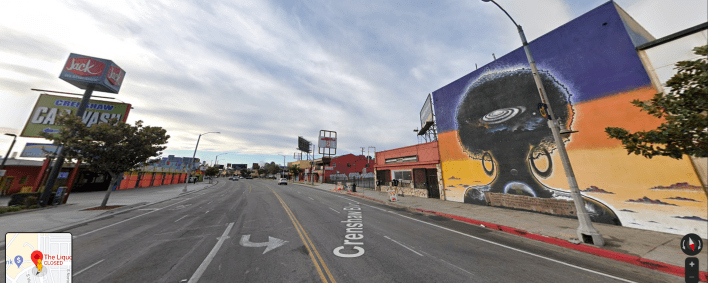
The new renderings presented in August (seen below and found here) put the mural back on Crenshaw, though it appears Elixir will still be above street level and will have less headroom than she has now.
The renderings for the CBG project, in contrast, suggest architect Stanley Saitowitz studied the layout of the neighborhood and took inspiration from the buildings seen around the community.
A number of the images from the renderings presented to the Crenshaw Corridor Design Review Board this past May detail how the proposed buildings mimic the "rhythm," scale, and elements found in the immediate area (below). The final set of buildings will stand five stories tall (containing 56 2-bedroom units, 48 1-bdrms, and 20 studios), have 6,000 square feet of space on the ground floor for retail, 100 bicycle parking spaces, and 60 vehicle parking spaces.
The question for many in the community, however, is less about whether the buildings will blend in but whether they portend a demographic shift that could fundamentally change the corridor.
In 2014, Leimert Park Village stakeholders launched the 20/20 Vision Initiative - an effort to put Leimert Park on the map as an important cultural destination, both as a supportive gathering space/living lab for Black artists, innovators, and entrepreneurs and as a source for cutting-edge and creative work by those folks. Destination Crenshaw - the 1.3-mile-long open-air “People’s Museum” intended to honor Black stories, culture, and contributions while marking Crenshaw as an unapologetically Black space - broke ground earlier this year. And although the efforts of late rapper and entrepreneur Nipsey Hussle to revitalize Crenshaw and Slauson were suddenly stalled when he was killed on March 31, 2019, his team and business partner David Gross still intend to go ahead with plans to rebuild The Marathon with affordable housing, retail, and a Hussle museum, while continuing to support Black enterprise and "buying back the block" efforts via the launch of an opportunity fund.
The new projects along the corridor, in contrast, are likely to attract a younger, well-to-do set of tenants who have the kinds of options for both physical and upward mobility that too many in communities like Crenshaw have historically been denied. In a community that has seen its Black population disproportionately harmed by the foreclosure crisis over a decade ago and subsequently squeezed out by rising rents and lack of opportunity, questions of whom new housing is for will continue to loom large. [See below for deeper dives into that issue.]
To see the full presentations on the project, see the staff presentation here and the developer's presentation here. For more on the history of the changing landscape along the corridor and the legacy of segregation, see below.
- July, 2020: Project Planned for Liquor Bank Site to Go Before Crenshaw Corridor Design Review Board Tonight
- June, 2020: CIM Group Abandons Effort to Buy Crenshaw Mall; Community Members Take Victory Lap, Plan Next Steps
- April, 2020: Crenshaw Line Opening Pushed Back to Late 2021 - Nearly a Year Later than the Date Projected Six Months Ago
- January, 2020: Public Comment Period on Dorset Village Extended; Number of Proposed Affordable Units Dropped to 141
- November, 2019: Demolition of Dorset Village Planned for June of 2021
- September, 2019: L.A. Podcast Segment Begins Unpacking Nipsey Hussle’s Legacy with Chavonne Taylor, Tafarai Bayne, and Streetsblog L.A.’s Sahra Sulaiman
- August, 2019: Nipsey Hussle Understood Cities Better than You [A deep dive into the history of redlining and repressive policing in the community]
- August, 2019: City Attorney Keeps up Pressure to Evict Nipsey Hussle’s Legacy from Crenshaw and Slauson
- May, 2019: Billionaire Jeff Greene’s Plans to Raze Dorset Village Are About as Awful as You Might Imagine
- April, 2019: South Central Gives Nipsey Hussle the Send-Off of a Lifetime
- February, 2019: Destination Crenshaw and the Rise of We-Built-this-Place-Making
- November, 2018: Art, the Crenshaw/LAX Line, and the Stories We (Don't) Tell at Train Stations
- September, 2018: Project Planned for Lots at Expo/Crenshaw Takes Another Step Forward
- November, 2017: Metro Executive Management Cmte. Approves Six-Month ENA for Proposed Expo/Crenshaw Development
- November, 2017: When Your Renderings Suggest the Black Population Has Been Abducted by Aliens, It May Be the Least of Your Problems [Expo/Crenshaw]
- July, 2017: Baldwin Hills Crenshaw Plaza Offers Window into History of Redevelopment, Legacy of White Flight
- June, 2017: Ancestors v. Polka Dots: Some Thoughts on Approaches to “Place-Making”
- April, 2017: Leimert Park Envisions Infusing Culture into Autonomous Micro Shuttles
- January, 2017: Leimert Park Village Hosts Third Design Charrette
- July, 2015: Leimert Park People St Plaza Opens; Stakeholders Debate Building a Cultural Center
- October, 2014: Leimert Park People St Plaza: Making a Cookie-Cutter Program Fit a Cultural Community’s Aspirations
- January, 2014: So, Ground Has Officially Been Broken for the Crenshaw Line. What Does That Mean for People in the Area?
- December, 2013: Fighting Gentrification with Sankofa Red – a Repurposed Pay Phone
- April, 2013: Ring, Ring! Who’s There? The Leimert Phone Company!
- October, 2012: Late to Its Own Party, Endeavour At Least Has Decency to Put On a Good Show (photo essay)
- September, 2012: Science Center Given Approval to Remove Nearly 400 Trees to Make Way for Shuttle
- September, 2012: Endeavouring to Find Opportunities for Communities in the Wake of the Shuttle’s Passage
- June, 2012: What You Wish You Hadn’t Missed this Weekend: Art, Community, Masks, and Ancestors in Leimert Park
